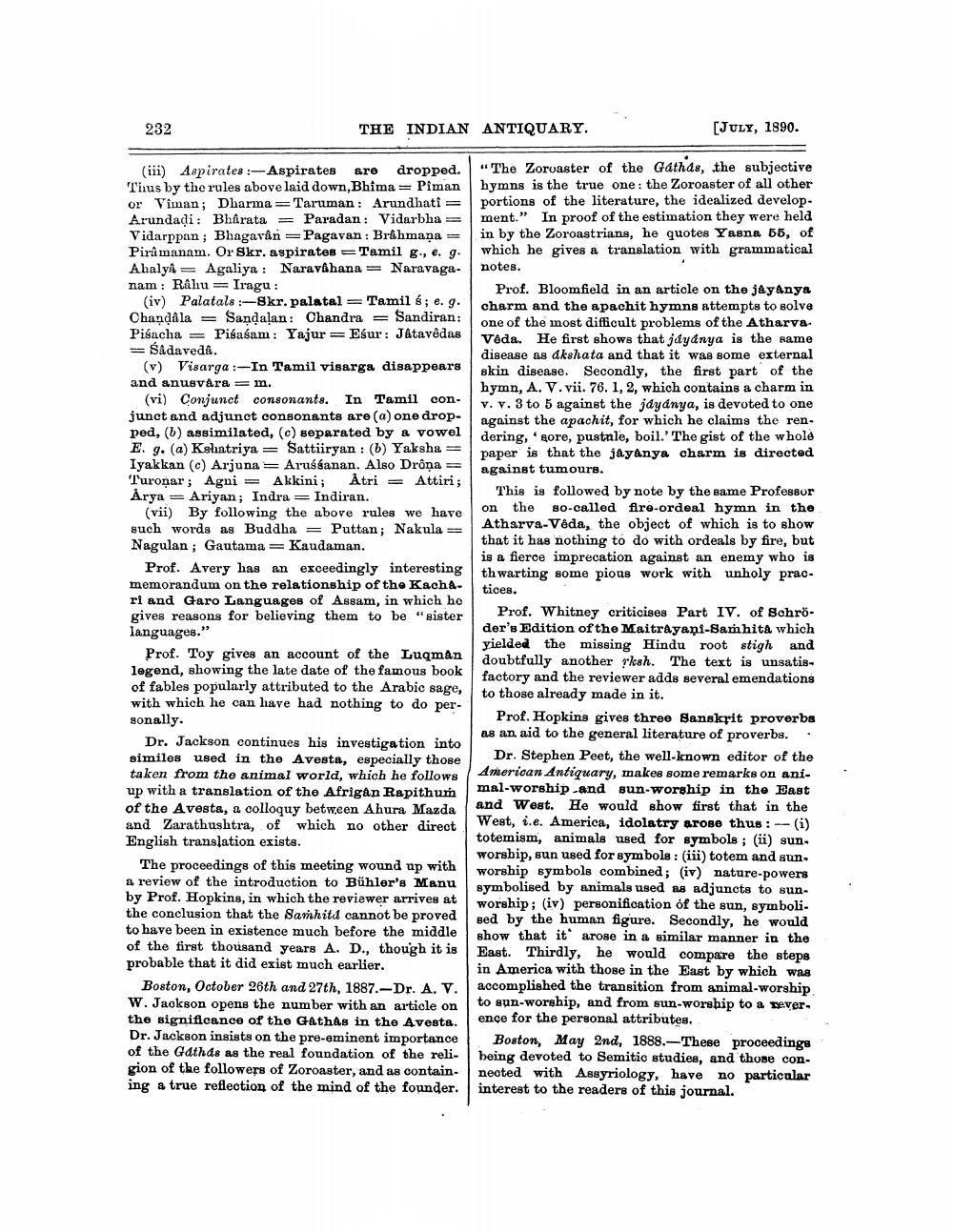________________
232
THE INDIAN ANTIQUARY.
(iii) Aspirates:-Aspirates are dropped. Thus by the rules above laid down, Bhima Piman or Viman; Dharma Taruman: Arundhati = Arundadi: Bharata Paradan: Vidarbha Vidarppan; Bhagavan - Pagavan: Brahmana Pirâmanam. Or Skr. aspirates Tamil g., e. g. Ahaly Agaliya Naravahana Naravaganam: Râhu Iragu:
=
(iv) Palatals-Skr. palatal Tamil é; e. g. Chandala = Sandalan: Chandra Sandiran: Pisacha Pisaśam: Yajur = Eśur: Jâtavêdas - Śâdavedâ.
(v) Visarga:-In Tamil visarga disappears and anusvåra m.
(vi) Conjunct consonants. In Tamil conjunct and adjunct consonants are (a) one dropped, (b) assimilated, (c) separated by a vowel E. g. (a) Kshatriya Sattiiryan: (b) Yaksha Iyakkan (c) Arjuna Aruśśanan. Also Drôna Turonar; Agni Akkini; Atri Attiri; Arya Ariyan; Indra Indiran.
(vii) By following the above rules we have such words as Buddha Puttan; Nakula Nagulan; Gautama = Kaudaman.
Prof. Avery has an exceedingly interesting memorandum on the relationship of the Kachari and Garo Languages of Assam, in which he gives reasons for believing them to be "sister languages."
=
Prof. Toy gives an account of the Luqman legend, showing the late date of the famous book of fables popularly attributed to the Arabic sage, with which he can have had nothing to do personally.
Dr. Jackson continues his investigation into similes used in the Avesta, especially those taken from the animal world, which he follows up with a translation of the Afrigån Rapithum of the Avesta, a colloquy between Ahura Mazda and Zarathushtra, of which no other direct English translation exists.
The proceedings of this meeting wound up with a review of the introduction to Bühler's Manu by Prof. Hopkins, in which the reviewer arrives at the conclusion that the Samhitd cannot be proved to have been in existence much before the middle of the first thousand years A. D., though it is probable that it did exist much earlier.
Boston, October 26th and 27th, 1887.-Dr. A. V. W. Jackson opens the number with an article on the significance of the Gathas in the Avesta. Dr. Jackson insists on the pre-eminent importance of the Gáthás as the real foundation of the religion of the followers of Zoroaster, and as containing a true reflection of the mind of the founder.
[JULY, 1890.
"The Zoroaster of the Gáthas, the subjective hymns is the true one: the Zoroaster of all other portions of the literature, the idealized develop. ment." In proof of the estimation they were held in by the Zoroastrians, he quotes Yasna 55, of which he gives a translation with grammatical notes.
Prof. Bloomfield in an article on the jayanya charm and the apachit hymns attempts to solve one of the most difficult problems of the AtharvaVêda. He first shows that jayanya is the same disease as dkshata and that it was some external skin disease. Secondly, the first part of the hymn, A. V. vii. 76. 1, 2, which contains a charm in v. v. 3 to 5 against the jdyánya, is devoted to one against the apachit, for which he claims the rendering, sore, pustale, boil.' The gist of the whole paper is that the jayanya charm is directed against tumours.
This is followed by note by the same Professor on the so-called fire-ordeal hymn in the Atharva-Vêda, the object of which is to show that it has nothing to do with ordeals by fire, but is a fierce imprecation against an enemy who is thwarting some pious work with unholy practices.
Prof. Whitney criticises Part IV. of Schröder's Edition of the Maitrayani-Samhita which yielded the missing Hindu root stigh and doubtfully another rksh. The text is unsatisfactory and the reviewer adds several emendations to those already made in it.
Prof. Hopkins gives three Sanskrit proverbs as an aid to the general literature of proverbs.
Dr. Stephen Peet, the well-known editor of the American Antiquary, makes some remarks on animal-worship and sun-worship in the East and West. He would show first that in the West, i.e. America, idolatry arose thus: -- (i) totemism, animals used for symbols; (ii) sunworship, sun used for symbols: (iii) totem and sun. worship symbols combined; (iv) nature-powers symbolised by animals used as adjuncts to sunworship; (iv) personification of the sun, symbolised by the human figure. Secondly, he would show that it arose in a similar manner in the East. Thirdly, he would compare the steps in America with those in the East by which was accomplished the transition from animal-worship. to sun-worship, and from sun-worship to a rever. ence for the personal attributes.
Boston, May 2nd, 1888.-These proceedings being devoted to Semitic studies, and those connected with Assyriology, have no particular interest to the readers of this journal.




